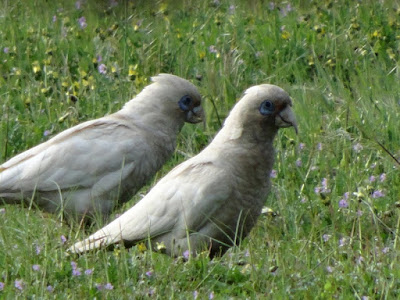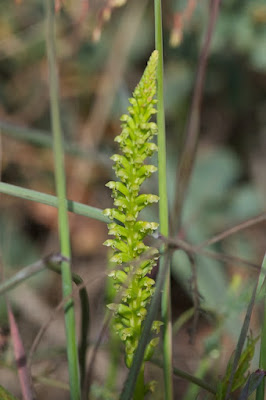After a grateful farewell to our hosts we were off again, following a twisting, roundabout route from Dandaragan back to Perth Airport, taking in what flowers we could on the way (Eileen was, as usual, indulgent as I hopped out of the car at various unlikely spots, eager to photograph yet another batch of plant life).
Flocks of corellas flew past us occasionally, causing me to regret the loss of my now-broken telephoto lens.
I did, however manage to get a closeup of a pair of Western Corellas (Cacatua pastinator) with Eileen's point-and-shoot. notice their long, projecting upper mandibles, a feature once thought to ally this species with the Long-billed Corella (C. tenuirostris) of the east.
As we were driving through almost completely human-modified agricultural country, it shouldn't be surprising that some of the roadside flowers I photographed were, in fact, introduced weeds, with charmless names like Blowfly Grass (Briza maxima). In North America, where this Mediterranean grass also grows widely, it is called Big Quakinggrass, which at least sounds less revolting.
Mind you, some weeds can be pretty gorgeous. A stand of Wild, or Pink, Gladiolus (Gladiolus caryophyllaceus), an introduced weed from South Africa now common in the lower Swan River Valley near Perth, makes a spectacular sight.
Looks, though, can be deceiving, and in Western Australia Wild Gladiolus is considered to be an invasive pest requiring active community management.
Native floers among the weeds included Yellow Buttercups (Hibbertia hypericoides)...
... and the unobtrusive spikes of Common Mignonette Orchid (Microtis media), one of the less impressive Australian orchids. Mignonette orchids are pollinated by small flies and other insects, or pollinate themselves if the insects stay away.
Our route thus far had taken us, mostly, southwards, but now we turned west towards the Indian Ocean coastline, crossing into native heathland between the Namming and Nilgen Nature Reserves east of Lancelin.
Here, once again, native flowers predominated, and the number and variety of available wildflowers began to increase.
Here, again, were stands of tall Acorn Banksias (Banksia prionotes) rising above the surrounding heath.
In the heathland shrub layer we found Pixie Mops (Petrophile linearis), another common heathland protea...
...and this attractive myrtle, presumably a species of Melaleuca, in full flower.
The sandy soil under the shrub layer supported numbers of herbaceous wildflowers, some now familiar and some new.
Common Catspaw (Anigozanthos humilis) was, indeed. common. I've posted a lot of photos of this photogenic plant in the course of describing our travels through Western Australia, but now that we're nearing the end of the trip I hope my readers won't mind a few more.
I also found it hard to resist the metallic flowers of Blue Tinsel Lily (Calectasia grandiflora), a member of the peculiarly southwestern Australian family Dasypogonaceae.
Golden Long-Heads (Podotheca gnaphalioides) still strikes me as a very odd-looking flower to be a member of the composite family (Asteraceae), if only because the individual flowers look like, well, individual flowers instead of parts of a daisy, thistle or dandelion.
This is a species of Trymalium, a small genus of plants confined to Australia's south and southwest. It is member of the buckthorn family (Rhamnaceae).
Hairy Yellow Pea (Gompholobium tomentosum) is one of the more recognizable of the southwest's many peas. Besides its pale yellow colour its inflorescence is noticeably hairy, as this photograph shows rather nicely.
I found two different species of trigger flower (Stylidaceae) here. This one, I believe, is Book Triggerplant (Stylidium calcaratum).
The much more local Pink Fountain Triggerplant (Stylidium brunonianum) is confined to the region around Perth. Its raceme of flowers is quite unlike the single flowers of the Book Triggerplant, but both share the trigger mechanism that snaps down on unsuspecting (well, I assume they are unsuspecting) pollinators; you can see the mechanism quite clearly in the flower facing us in the lower photograph.
By now we had to think about heading south, but we finished the first part of our last day with a quick run to the Indian Ocean coast at Lancelin where I had time for a snap of native pink Coastal Pigface (Carpobrotus virescens) sharing the sand dunes with a few yellow inflorescences of the exotic Capeweed (Arctotheca calendula).


































No comments:
Post a Comment